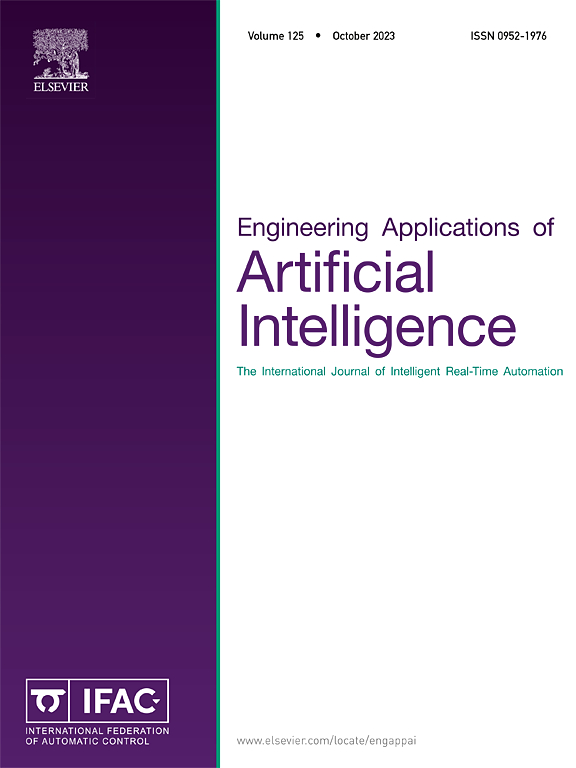基于迁移学习的碳纤维增强复合材料和粘合剂剩余刚度评估方法
IF 8
2区 计算机科学
Q1 AUTOMATION & CONTROL SYSTEMS
Engineering Applications of Artificial Intelligence
Pub Date : 2025-07-02
DOI:10.1016/j.engappai.2025.111624
引用次数: 0
摘要
这项工作提出了一个基于迁移学习的编码器-解码器框架,以预测碳纤维增强复合材料和粘合剂中加载条件与剩余刚度之间的关系。编码器由卷积神经网络(CNN)和双向长短期记忆(Bi-LSTM)组成,将时间序列加载信号提取到潜在变量中,并捕获它们的依赖关系。解码器采用多层感知器(MLP)将这些潜在特征映射到剩余刚度。运用迁移学习策略,兼顾个体差异性,进一步提高准确率。通过两种不同材料系统的随机和恒载荷疲劳试验,验证了模型的有效性和鲁棒性。在随机疲劳数据下,该模型具有较强的学习能力。在随机疲劳数据下,该模型具有较强的学习能力。与支持向量机(SVM)和随机森林(Random Forest)等经典模型或单个CNN和Bi-LSTM网络等更简单的深度学习架构相比,本文提出的架构具有更高的预测精度和回归结果,均方根误差(RMSE)为0.154,决定系数(R2)为0.931。在恒幅疲劳数据集中,当使用合理的训练数据集大小时,该模型能准确识别不同的材料,并表现出令人满意的鲁棒性。本文章由计算机程序翻译,如有差异,请以英文原文为准。
Transfer learning-based approach for evaluating residual stiffness in carbon fiber reinforced composites and adhesives
This work proposes a transfer learning-based encoder-decoder framework to predict the relationship between loading conditions and residual stiffness in carbon fiber reinforced composites and adhesives. The encoder, built from a Convolutional Neural Network (CNN) and Bidirectional Long Short-term Memory (Bi-LSTM), extracts time-series loading signals into latent variables and captures their dependencies. The decoder employs a Multilayer Perceptron (MLP) to map these latent features to residual stiffness. Transfer learning strategy is used to account for individual variability and further improve accuracy. The model's effectiveness and robustness are validated through random and constant loading fatigue experiments from two different material systems. Under random fatigue data, the model demonstrates strong learning capabilities. Under random fatigue data, the model demonstrates strong learning capabilities. Compared to classical models like Support Vector Machine (SVM) and Random Forest, or simpler deep learning architectures like individual CNN and Bi-LSTM networks, the proposed architecture shows enhanced prediction accuracy and regression results, achieving a Root Mean Square Error (RMSE) of 0.154 and a Coefficient of Determination (R2) of 0.931. In constant amplitude fatigue datasets, the model accurately identifies different materials and exhibits satisfactory robustness when reasonable training dataset size is used.
求助全文
通过发布文献求助,成功后即可免费获取论文全文。
去求助
来源期刊

Engineering Applications of Artificial Intelligence
工程技术-工程:电子与电气
CiteScore
9.60
自引率
10.00%
发文量
505
审稿时长
68 days
期刊介绍:
Artificial Intelligence (AI) is pivotal in driving the fourth industrial revolution, witnessing remarkable advancements across various machine learning methodologies. AI techniques have become indispensable tools for practicing engineers, enabling them to tackle previously insurmountable challenges. Engineering Applications of Artificial Intelligence serves as a global platform for the swift dissemination of research elucidating the practical application of AI methods across all engineering disciplines. Submitted papers are expected to present novel aspects of AI utilized in real-world engineering applications, validated using publicly available datasets to ensure the replicability of research outcomes. Join us in exploring the transformative potential of AI in engineering.
 求助内容:
求助内容: 应助结果提醒方式:
应助结果提醒方式:


